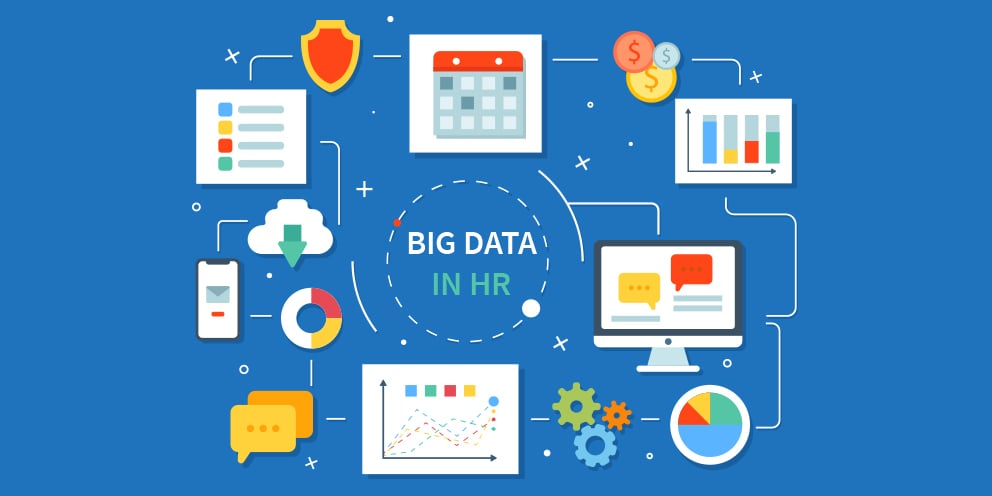
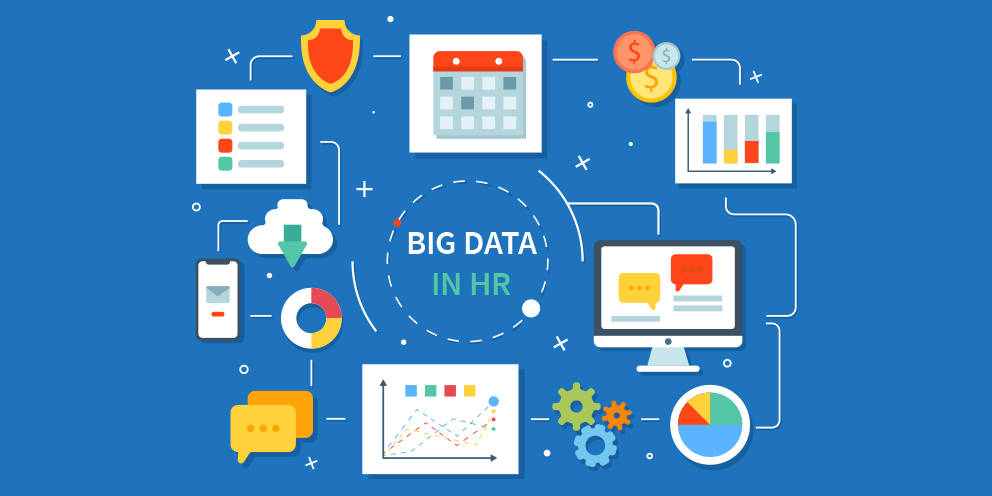 HR Big Data
HR Big Data 
We have been hearing and discussing the need for HR leaders to become strategic partners for 25 years. Until recently only a small percentage of CHROs were able to achieve it. The primary reason is the accurate perception of HR as transaction processors and internally-focused practitioners of people management. We can change that perception.
Strategic alignment is a high priority. The annual Information Services Group (ISG) survey on HR on service delivery trends placed strategic alignment at the top of planned improvements in HR.
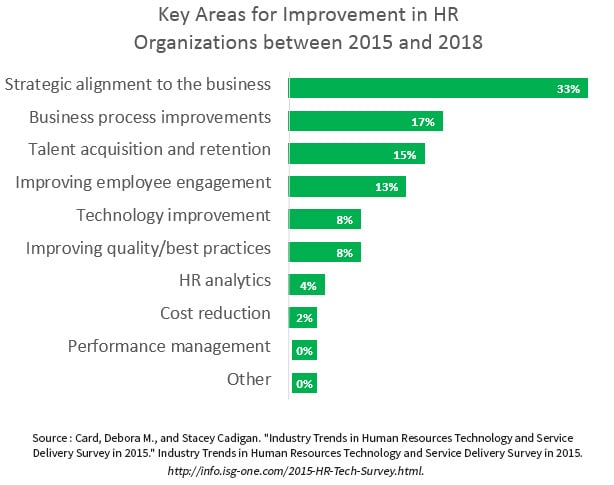
That report also showed us that improving HR analytics capabilities and value is not a priority, and that is a barrier to alignment. Until practitioners cross that barrier, true alignment will not exist. How can strategic alignment happen if we do not analyze our processes and align them with quantitative business outcomes? It is the logical starting point that enables us to speak the language of the enterprise.
A significant shift in human capital management technology has changed roles in HR -- but there still is a difference between what business leaders want HR to do and what HR is doing. A 2015 Harvard Business Review Analytics Services Report quantified the gap and gave us a clearer picture of both the problem and the solution.
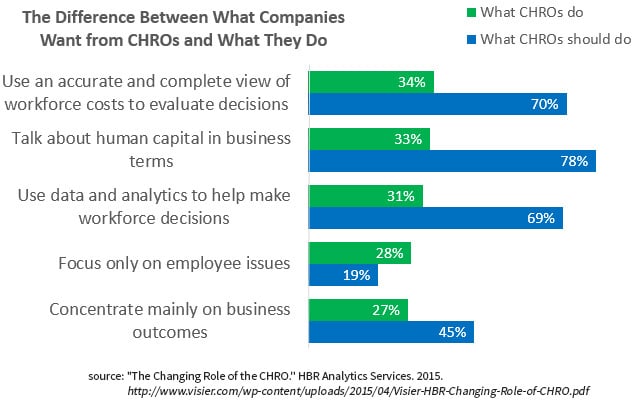
The common thread is analytics. The gaps relate directly to the need for the flow of information related to business outcomes. We cannot even begin to address the alignment issues until learn how to analyze the data.
A robust analytics function will not only provide the information HR needs to align itself with the business, but it also provides the language necessary to engage in the business conversation. It will change the conversation from internal efficiency measures to outcomes like cost, revenue, and return on investment. People create revenue, and we can measure their impact. Sometimes we only have derivative measures, but the proper analysis will demonstrate the value.
Let us offer some answers to the obstacles in your way. HBR Analytics Services surveyed leaders and practitioners to learn why we have not seen more adoption of HR analytics. We provide comments on each of them.
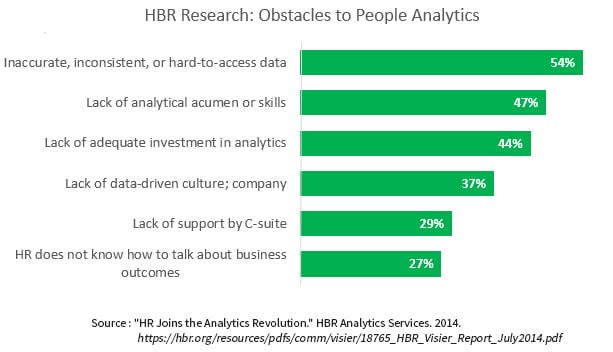
Inaccurate, inconsistent, or hard-to-access data. No one has perfect data. Many hands touch your data in many ways. No matter how hard you try, it is going to be a bit messy.
Payroll data needs to be exact. Turnover data does not. Does it matter whether you are losing 35% or 45% of your high-performing employees? Can you take action on the information?
If necessary, services are available to help you clean your data. We can design algorithms that will help with accuracy, but we all need to acknowledge that our data will never be pristine.
If your HR data is hard to get, your IT team should be able to help. If not, many very reliable consulting companies can help.
Another thing to consider: If your information is so hard to get, is it time to upgrade your technology?
Lack of analytical acumen or skills in HF. Most of analytical skill is learning how to ask the right question. One of the best places to start is in return on training investment. If you provided sales skills training, did it increase revenue? If you provided customer service training, did average revenue per employee increase? In recruiting, did your new assessment improve hiring manager satisfaction? Did it lower turnover? If so, how much did it lower turnover cost?
Analytical skills training is everywhere, and much of it is free. Udemy offers a complete training course at a very reasonable cost.
Lack of adequate investment in analytics. If you are changing or upgrading your HR software, now is the time for analytics. Almost all HR software platforms provide some level of analytics built in, and the capabilities are getting better and easier to use. Separate analytics platforms are coming to market with lower costs and better capabilities. We wrote recently about how to get started with no budget. It describes how you can use a small success to build your case for better tools.
Lack of a data-driven culture. Partner with Finance, Marketing, Sales, and Logistics to change the culture. They need data analytics as much as you do, and they are probably looking for HR solutions for their productivity problems. In our experience, if your leadership is not data driven, one analytics success will change their minds.
Lack of Support by C-Suite. You can overcome this with alliances. Work with business leaders to solve their problems and measure their success and the impact on business results. Nothing gets the C-Suite’s attention like improved results.
HR does not know how to talk about business outcomes. Learning the business should be your top priority. Your allies in Finance, Marketing, Sales and Operations will help you with this if you reach out.
To become a strategic business partner, HR must apply the same analytical discipline that Finance, Marketing, Logistics, and every other business function has been using for many years. If you partner with them, we think you will be surprised at the amount of help available in your organization.
"The Changing Role of the CHRO." HBR Analytics Services. 2015.
"HR Joins the Analytics Revolution." HBR Analytics Services. 2014.

Considering all the buzz about big data in Human Resources, we haven’t seen much progress. The commonly cited reason is a lack of skills, but we think it is a lack of understanding and fear of the unknown.
One of the ways people create buzz about a topic is to create a cloud of mystery around it. It’s like you are standing at the bottom of a mountain as they stand on the top and shout about the magnificent view. You would like to climb the mountain, but there is a dense cloud around the mountain so you can’t see how to get there.
Let’s see if we can remove some of the mystery.
We see many reasons why HR hasn’t embraced analytics yet. We have listed some of the objections we hear most frequently. We encourage you to let go of the “yabbuts” and take a fearless, realistic view of how to get started.
We don’t have the skills. Somewhere in your organization is an accountant, engineer, or another specialist you know as a spreadsheet wizard. That person has the skills to become your data analyst with a little study, training, and coaching.
Our data is in different systems. Every person-based business application has a unique person identifier. A lookup table with all the identifiers will bring all the data together in a database, spreadsheet, or analytics engine. Start by creating that table.
We don’t know how to do the math. Your accounting wizard or engineer does or can learn it in a day.
Our data isn’t accurate. No one has perfect data, and it doesn’t need to be perfect to point you in the right direction. You are dealing with large sets of aggregate data, and a few errors here and there won’t be significant. If you are working with an analytics consultant, they will deal with data errors.
It takes too much time. Only in the beginning. It gets much easier. Something that took you four days the first time will soon take ten minutes as you develop your methods.
It costs too much. Our former analyst completed his first big data analysis project with zero budget using existing software. You will eventually want better technology, but you can have an impact with what you have.
The problem, as we see it, is that the ongoing discussion is from the wrong perspective. Nearly everything we see and hear is about the view from the top of the mountain. Stop and take a realistic view of where you are today using the Gartner Analytics Maturity Model.
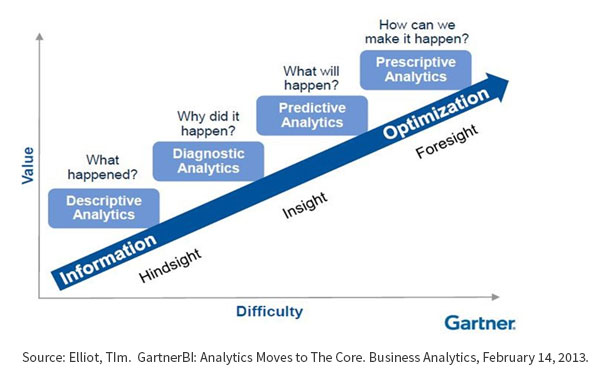
At the first step of the maturity model, we have reports with basic information about what happened. We can answer questions like:
At the second level, we can begin to do some diagnostic analysis to discover why things happened.
At the third level, we can do some predictions.
At the top level, our systems can give us prescriptive analytics and decision support.
Don’t fret If you are standing on the bottom step. You are right where you need to be, and help is on the way. There are two reasons why you can be confident about taking on analytics:
Matthew Lymbery and John Cusack of analytics firm Activ8 Intelligence, provide a better way to think about the data you already have. They present four types of data you can get from your systems right now (Figure 2).
Basic data requires no further manipulation.
Categorized data is derived by taking a large number of categories and simplifying them.
Deduced data is created by using a related data point. For example, employees who use remote connections for an extended time are mostly likely telecommuters.
Calculated data derives from two or more data points. A common example is compa-ratio.
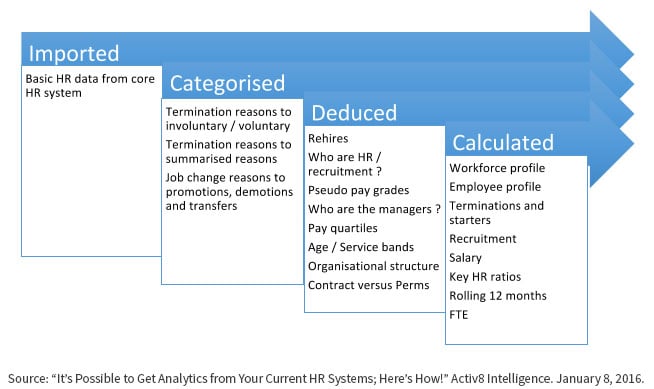
Tangible results happen when you start asking the right questions. Try this example from Lymbery and Cusack:
Which managers are good at hiring good people?
A few steps will give you a metrics your CEO will love:
The result will be information you can use to take action to reduce the ratio of bad hires. Before you do, you might want to consider that the problem might not be the candidates. See our blog article on quality of hire for more information.
Start your analytics journey with a small success. Think about what keeps your CEO up at night. Frame it in terms of a question, and then dig into your data to see what information you put together to give you some insight into solutions. Your success will give you the leverage to ask for the resources to take the next big step.

After years of promotion, publicity, and discussion, the exponential growth we have expected in big data analytics in HR has begun. The percentage of companies capable of predictive people analytics doubled from 2015 to 2016 to eight percent. Seventy-seven percent of respondents to Deloitte’s Global Human Capital Trends 2016 survey now see people analytics as important to their businesses.
Part of the reason things are changing is that the software needed to gather and analyze data become universally available. Analytical capabilities are now built into human capital management technology or are available off the shelf. Most companies have upgraded their technology in the past few years, and analytics is a standard feature of modern people management platforms.
If you are just now contemplating getting into people analytics in your organization, we recommend you start with recruiting There are two reasons for our recommendation.
One is that you have using automated recruiting for any length of time, you have a wealth of data about the people you hired. You have information about their education and work history. You have detailed information you gathered in assessments. You also have information about how they handled interview questions. Josh Bersin noted in a recent podcast how a company found that people who exaggerated their work experience had a high tendency to become toxic employees.
The other reason is that recruiting, as Bersin says, is “an easy win.” A small change in how you select people can have a significant impact on organizational performance. A large call center we worked with impacted turnover by showing its recruiters how introverts stayed longer and performed better than their extroverted colleagues.
We have long known that managers tend to hire people like themselves. Part of it is personal biases. Some of it is the belief that their experience and background is the best model for success. Having data on which employees stay longer and perform better will help those managers overcome their misconceptions.
We do not recommend you rush out and invest in a company-wide analytics project to measure everything you can. As in our other recommendations about organizational change and alignment, we recommend you start with a small, high-impact project that will show the bottom-line value of statistical analysis.
People analytics will soon become a foundational strategy of successful organizations. If you have not already done so, we urge you to get started right away. Your company’s bottom line will thank you.
References
Weisenfeld, David B. "Podcast: HR Analytics on the Rise - Moneyball Meets the Workplace." EXPertHR.
Pixentia is a full-service technology company dedicated to helping clients solve business problems, improve the capability of their people, and achieve better results.